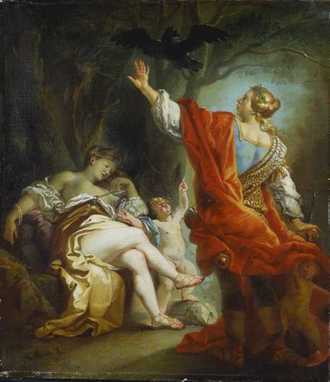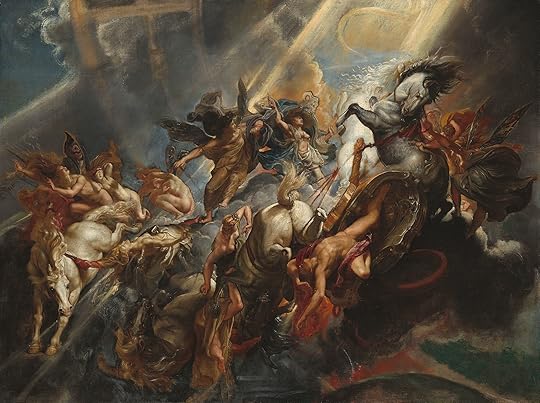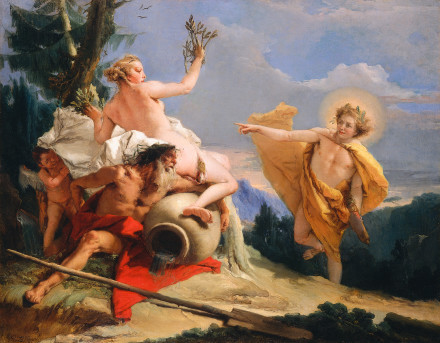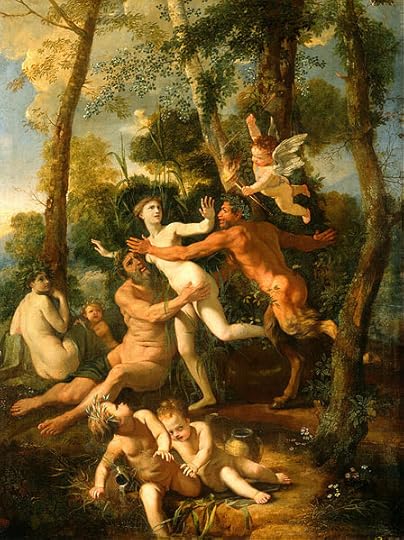 Kalliope’s
Comments
(group member since Aug 28, 2018)
Kalliope’s
Comments
(group member since Aug 28, 2018)
Kalliope’s
comments
from the Ovid's Metamorphoses and Further Metamorphoses group.
Showing 501-520 of 610
 Roger wrote: "I also engaged on a long discussion a bit earlier with Roman Clodia and others about the morality of the Daphne episode,
Roger wrote: "I also engaged on a long discussion a bit earlier with Roman Clodia and others about the morality of the Daphne episode,..."
I also feel that applying our morals to previous ages is a double edge blade... I prefer to stay within the analytical approach and stay away from the morals. The latter can lead also to a desire to change or censor history, which for me can have very dangerous results.
In Ovid I am finding the humour and the politics, that RC pointed at, more fascinating.
The images of some of these beings being deprived of their speech (and like the Io episode managing to write her name - ´I´ in Italian- with her hoof, and therefore retaining her human abilities) are fascinating me - for they raise issues of (human) identity and artistic creativity.
 On the metamorphosis of Phaeton's sisters and Cycnus...
On the metamorphosis of Phaeton's sisters and Cycnus...Again, another print by
Hedrik Goltzius. 1590.

 Jim wrote: "Of all the tales included in the Met, surely Phaeton's wild ride is the most powerful, dramatic, earthshaking episode. It impacts not just one part of the world or a few mortals and gods; the entir..."
Jim wrote: "Of all the tales included in the Met, surely Phaeton's wild ride is the most powerful, dramatic, earthshaking episode. It impacts not just one part of the world or a few mortals and gods; the entir..."Agree, it is a passage that takes your breath away.
 Jim wrote: "The Phaethon disaster takes aetiology to a whole new level, accounting for a whole host of cosmic phenomena. The scorching of the chariot as it plunged earthward accounts for the Etiopians' blacken..."
Jim wrote: "The Phaethon disaster takes aetiology to a whole new level, accounting for a whole host of cosmic phenomena. The scorching of the chariot as it plunged earthward accounts for the Etiopians' blacken..."Jim, thank you for this comment. But as it belongs to Book II, I will put a link to your comment in that thread. I will also comment there.
 On the sad episode of Apollo and Coronis...
On the sad episode of Apollo and Coronis...Johann Zoffany. 1759. Private Collection.

In this one Apollo has already slain her and full of regret is trying to bring her back to life by collecting some herbs (not a detail in Ovid)... The pyre to burn her is on the right, in the background.
Adam Elsheimer. 1607. Walker Art Gallery, Liverpool.

 I keep being perplexed by the way Ovid connects the various episodes... And now he leaves a 'cliffhanger', as Historygirl points out, at the end of Book II. The Europa story, one of the more popular ones in the whole work.
I keep being perplexed by the way Ovid connects the various episodes... And now he leaves a 'cliffhanger', as Historygirl points out, at the end of Book II. The Europa story, one of the more popular ones in the whole work.
 Roger wrote: "
Roger wrote: "I might as well post the great Titian painting of Diana discovering Callisto's pregnancy, one of the seven "poesies," or scenes from Ovid, painted for P..."
This is an excellent selection, Roger. There are so many paintings of Callisto, that I felt somewhat overwhelmed at trying to trace them...
 Roger wrote: "
Roger wrote: "If this is in Washington, I should know it, but I don't. It is truly magnificent,..."
I hope it is on display and you can watch it next time you are there, Roger. As I mentioned, it is not very large in spite of its theme and rendition.
It is a relatively 'recent' acquisition for the Museum.
https://www.washingtonpost.com/archiv...
 Roman Clodia wrote: "On the Io story, this is the first time in Ovid we meet Juno as the humorous stock figure of the 'nagging' wife ('Where was her husband? She looked all around. She was quite familiar | with Jupiter..."
Roman Clodia wrote: "On the Io story, this is the first time in Ovid we meet Juno as the humorous stock figure of the 'nagging' wife ('Where was her husband? She looked all around. She was quite familiar | with Jupiter..."Juno reminded me of her role in the Opera Semele, which I saw performed by the the NYCity Opera company (no longer active)... I believe we will encounter the myth later on... In that Semele production, Jove was impersonated as JFK, Semele as Marilyn Monroe and Juno as Jackie...
 Jim wrote: "Moving along:
Jim wrote: "Moving along:According to a Hopi legend that predates the arrival of the first Europeans in the Americas, there was once a boy who lived with his mother's mother, never knowing who his father was;..."
Intriguing indeed, Jim. Thank you.
 Roman Clodia wrote: "Their typology highlights how dangerous the world is for beautiful wood nymphs who are the prey of male Olympians...
Roman Clodia wrote: "Their typology highlights how dangerous the world is for beautiful wood nymphs who are the prey of male Olympians... reply | delete | flag *
..."
Thank you RC... Yes, I am trying to feel 'comfortable' with the specific myth to see if I can detach myself and pay greater attention to the way Ovid is presenting it.
As for the nymphs... this Jove/Jupiter is really quite something... He wanted a world that was safe for the lesser deities, such as the nymphs, and it turns out that the greatest danger for these creatures is himself...!!!!
 To depict Phaeton's fall is a great challenge and Rubens, unsurprisingly, felt he could meet it..
To depict Phaeton's fall is a great challenge and Rubens, unsurprisingly, felt he could meet it..Rubens. Fall of Phaeton. 1606-8. Washington National Gallery.

We see Phaeton drawing an arc while falling, and the four horses. The Earth is already beginning to burn, and Apollo/Helios is shown as Light.
It is not very large. This theme and rendition would call for a huge painting. But this is a young Rubens still; he painted it in Italy while still being an 'apprentice' of sorts, and who had to prove his powers. Far from the huge painting of the Adoration of the Magi that he painted for the Antwerp City Hall.
The young Rubens, however and unlike Phaeton, could rise to the heights and control 'his' chariot....
 When posting paintings, I feel as if we are reversing Ovid's ecphrasis, the written description of images, turned back into images.
When posting paintings, I feel as if we are reversing Ovid's ecphrasis, the written description of images, turned back into images.The beginning of Book II describing the 'artwork' of the doors of of the palace of the Sun, as made by Vulcan, is a beautiful echprastic section.
No wonder Vulcan, or the 'craftsman god', fascinated European painters... their 'godly' alter-ego.
 Roman Clodia wrote: "Great, Peter. Isn't Ovid somewhat poking fun at, or, at least, drawing attention to, the numerous 'versions' that existed in his time of the creation?"
Roman Clodia wrote: "Great, Peter. Isn't Ovid somewhat poking fun at, or, at least, drawing attention to, the numerous 'versions' that existed in his time of the creation?"RC and Peter... yes... I begin to ask myself how much of what Ovid is writing about, did he believe in...
Certainly not an expert, but this reads very different from the much more earnest Greek accounts.
 I found Book 1 a very complex one... The Cosmogony, with a very ambiguous identification of deity/deities; the Ages of the Universe with the (main?) god appearing on the second period (!) and with an intriguing scientific content; the destruction and regeneration of the world; the three (?) generations of Humanity; the sudden shift in the focus to a series of fantastical stories linked in a perplexing way...
I found Book 1 a very complex one... The Cosmogony, with a very ambiguous identification of deity/deities; the Ages of the Universe with the (main?) god appearing on the second period (!) and with an intriguing scientific content; the destruction and regeneration of the world; the three (?) generations of Humanity; the sudden shift in the focus to a series of fantastical stories linked in a perplexing way...Even if we are already moving to Book II, I think I will give this one another run through.
 Historygirl wrote: "So much to think about...I found the description of the Age of Iron important, because it is linked to gold, plunder, piracy by sea and colonial divisions of land—we seem to be back in the narrativ..."
Historygirl wrote: "So much to think about...I found the description of the Age of Iron important, because it is linked to gold, plunder, piracy by sea and colonial divisions of land—we seem to be back in the narrativ..."Thank you, Historygirl for pointing at the subtle references in this mythical account to Ovid's own contemporary Augustun world.
I keep asking myself how Ovid's contemporary readers reacted to this poem. For them, I assume all cultivated in greater or lesser degree, the mythical core stories would have been already known (less so for us in the C21). So, what did they find so attractive in Ovid's version?
And on the painting we are posting... What is interesting is that even if they Greek myths as continued by the Romans can be found in a multiple of textual sources, the artists of the European tradition used Ovid's poem as their main source.
For those of us interested in art, this is then a gold mine.
 In post 122, I added a second version by Rubens, of the Mercury and Argus, in the Dresden Museum also.
In post 122, I added a second version by Rubens, of the Mercury and Argus, in the Dresden Museum also.
 Another interesting rendition of the Apollo & Daphne. What is striking here is the presence of Daphne's father, the River-god Peneus. In the text it is not explicit that the father is the one who answers her prayers and provokes her metamorphosis saving (?) her... Tiepolo has also included the naughty Cupid, clearly enjoying himself.
Another interesting rendition of the Apollo & Daphne. What is striking here is the presence of Daphne's father, the River-god Peneus. In the text it is not explicit that the father is the one who answers her prayers and provokes her metamorphosis saving (?) her... Tiepolo has also included the naughty Cupid, clearly enjoying himself.Gianbattista Tiepolo. Daphne & Apollo. 1755-176. Washington National Gallery.

 I have just received the book that Elena recommended, and which is in the Bookshelf of the groupOvid and the Metamorphoses of Modern Art from Botticelli to Picasso.
I have just received the book that Elena recommended, and which is in the Bookshelf of the groupOvid and the Metamorphoses of Modern Art from Botticelli to Picasso.I will probably start it later on, but I was just flicking through and found some images which have not been posted here yet.


